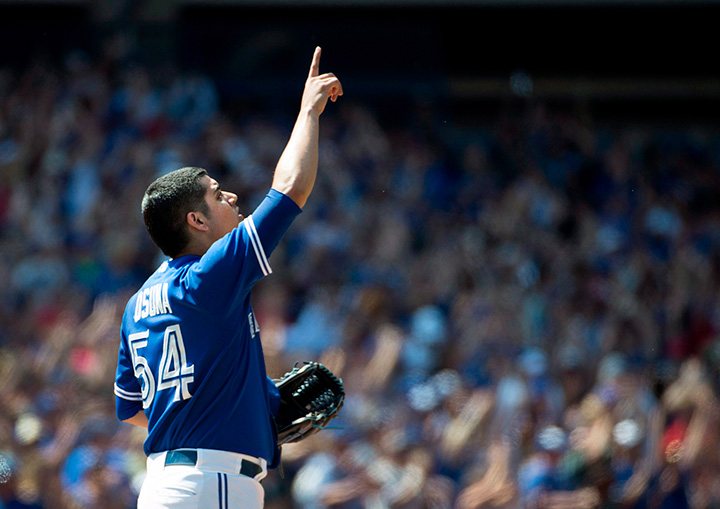TORONTO – The Toronto Blue Jays are right in the middle of a pennant race and people are coming out of the woodwork and jumping on the bandwagon in support of Canada’s team.

As of Wednesday, the Blue Jays hold a 1.5-game lead over the New York Yankees for first place in the American League East.
Home games are sold out; Canadians are making trips south of the border to support the Boys of Summer as they make a push for October baseball.
Baseball, like many sports, is filled with jargon and for newcomers to the game, the commentary might be a little confusing.
Global News has put together a list (in no particular order) of commonly used terms to help bandwagon-jumpers understand America’s pastime.
First of all, what is a bandwagon-jumper? It’s someone who decides to support something (in this case a team) only once it becomes popular and/or successful.
Okay, now to baseball.
Walk-off win & walk-off home run: When the home team is losing or tied with the visiting team and scores a run in the bottom half of the 9th inning (or later if the game goes into extra innings). For example, on Sept. 1, Ryan Goins hit a game-ending home run (walk-off home run) in the bottom of the 10th inning as the Jays beat the Cleveland Indians 5-3.
Ace: David Price, err, a team’s best starting pitcher.
Closer: A pitcher who comes out of the bullpen to finish the game. (Roberto Osuna for example)
Bullpen: The term refers to an area on the field as well as the team’s group of relief pitchers and closing pitchers.
Rubber: The white strip of rubber atop the pitching mound.
Dish: Home plate
Fastball: A pitch thrown at a high velocity with little movement.
Heater: Another term for a fastball
Curveball: A pitch that breaks from a straight path toward home plate.
Knuckleball: A pitch thrown with little to no spin. A pitcher usually grips the ball with their knuckles or fingertips, or a combination of both.
Slider: A mid-to-high velocity pitch that breaks or curves down towards home plate.
Eephus pitch: An uncommon pitch used to fool hitters. The ball is thrown with a low velocity and a high arc, similar to a softball pitch.
Balk: An illegal motion by a pitcher to deceive a baserunner.
RBI: An abbreviation for Run Batted In and is a statistic and credit given to a batter for driving in another player for a run.
ERA: An abbreviation for Earned Run Average. A statistic given to a pitcher based on the average number of runs given up per nine innings.
Full count: When a batter has three balls (one more ball is a walk) and two strikes (one more strike and the batter is out)
Sac fly: When a batter hits a fly ball and is caught for an out, but a runner scores after tagging up on a base following the out.
Caught looking: When a batter is called out on strikes without attempting to swing the bat at the ball.
Pickoff: When a pitcher or catcher quickly throws the ball to a baseman to catch a runner off the base when the ball has not been hit into play.
Bunt: Instead of swinging, a batter lightly holds the bat in front of home plate and tries to tap the ball into play. This technique is used to advanced baserunners into scoring postion.
Cleanup hitter: Is the fourth player in the batting order. Usually a strong hitter, the fourth batter’s job is “clean the bases” by hitting the ball in play to allow baserunners to score.
Cut-off man: A player who intercepts a long throw from an outfielder to relay it to another base.
Jam: When a pitcher gets him/herself into trouble with the opposing team threatening to score.
No hitter (No-No): When a pitcher completes a game without allowing the opposing team to record a hit.
Perfect game: When a pitcher completes a game without allowing the opposing team reach base.
Behind the count: When a batter has more strikes against him than balls. For a pitcher, it’s the opposite.
Steal (stolen base): When a baserunner successfully advances to another base while the pitcher is throwing to a batter.
Checked swing: When a batter stops the swing of the bat before it crosses the front of home plate.
Touch ’em all: Hitting a home run (touching all the bases).





Comments